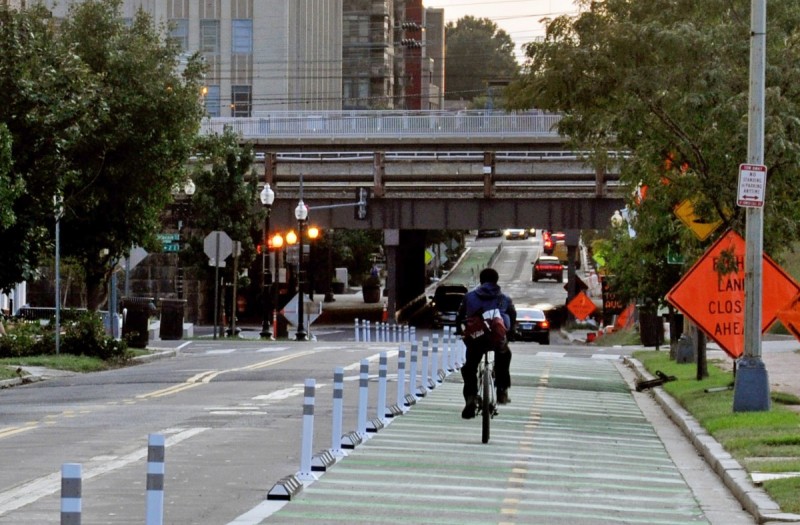Why does this protected bikeway flip from one side of M Street NE to the other?

Image by Dan Malouff licensed under Creative Commons.
Ride a bike along M Street NE from NoMa toward Union Market and you can enjoy a nice protected bikeway. But when you get to 3rd Street NE, suddenly—huh? The bikeway switches to the other side of the street. What's up with that?
Some people who bike there, including some of our contributors, have been wondering about the design of this new protected bikeway. Jim Sebastian, associate director for planning at the District Department of Transportation (DDOT) explained some of the reasoning.
There was an existing bikeway on the south side of M, west of the train tracks (connecting to the Met Branch Trail, whose entrance is on the south side, and wrapping around to First Street to Union Station). But farther east, at 4th Street NE, there are two reasons to want it on the north side.
One is connecting it at the corner on 4th Street; if it's on the north, people biking can wrap around to 4th without another crossing. The other is that M east of 4th is one-way but has a contraflow lane on the north (westbound) side.
The view looking west. Image by Dan Malouff licensed under Creative Commons.
The DDOT team felt that switching sides at a 4-way stop was better than at an intersection with a traffic light, Sebastian said. Using a signalized intersection would require potentially redesigning the light, such as with a dedicated phase for bikes. At 3rd, instead, the stop signs make everyone stop anyway, and people on bikes can just go through on their turn.
Tony Goodman, a former Advisory Neighborhood Commissioner who lobbied for a bikeway on this part of M, said,
This extended facility on M NE has been in the planning stages for a long time, and was not an easy one for DDOT's Mike Goodno to design. There were some difficult design decisions made with the safety of bicyclists in mind, but of course now that it's installed it may need some adjustments. Already the 4th Street section (from M to Florida) has some issues with persistent illegal parking & loading, so DDOT is looking to make adjustments there soon.
Is this working?
DDOT chose this after a lot of thought, Sebastian said, but they also would like feedback on whether and how it's working. Goodman wrote:
I've ridden this new section several times recently, and it hasn't felt particularly comfortable. There are definitely benefits to it being on the north side of M in the 300 block because it avoids conflicts with two alleys and a street (Abbey), but switching sides isn't very fun. However, it may be improved with more paint or signs. I don't know what the best solution would be for these couple of blocks… maybe just bike lanes on both sides of the street instead would work better, or keeping it on the south side until 4th, or switching at Delaware. All I know is that DDOT definitely put a lot of thought into this, and their thinking & planning process hasn't stopped just because they have some paint on the ground. So hopefully this will continue to improve.
Steve Seelig thinks it's not a bad design:
I used it the other day with my 8-year-old who was riding his own bike, and have been using that intersection for a while. Being able to head south from Union Market to the NoMa Metro on protected bike lanes is pretty great. My experience last week and for the past several years is that intersection where it shifts is fairly benign and is the best location on M Street for the shift. Even before the bike lane installation, cars at the cross street have always given great deference to cyclists at that intersection, mostly because it is not a through street and lot of them are turning onto M Street. Taking bikes off the sidewalk past REI is really a great addition.
I will say that the left turn from southbound 6th Street to westbound M Street is very iffy and does present a lot of challenges.
Howsabout a roundabout?
A mini-roundabout in Seattle. Image by SDOT photos licensed under Creative Commons.
Our contributors wondered if a roundabout, or “mini-circle,” could work. @thejonrose suggested as much on Twitter. Unlike DC's circles which are large and often have traffic signals, a mini-roundabout is little more than a small planted area in the middle of an intersection which forces all traffic to go around to the right in a little circle. They're everywhere in Seattle; here's one in Arlington.
Instead of waiting for cars to stop and riding through at a diagonal, people on bikes could go around the little circle. And so would drivers, keeping traffic flowing but at a slow speed. Would that work here? Sebastian said the team would look into the idea.
Regardless, there's no easy answer. Residents are better off with a protected bikeway here; either this is the right spot, or they can make adjustments.
Have you ridden here? What has your experience been?
